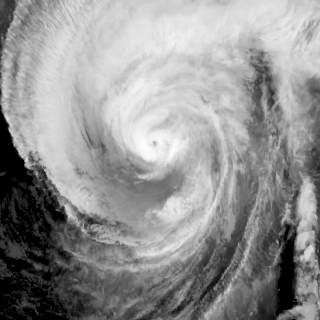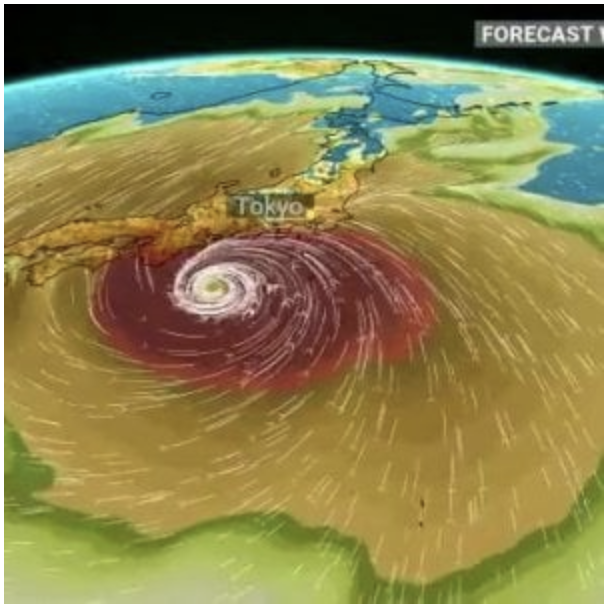
Super typhoon Hagibis
Typhoon Hagibis, the 19th named Pacific region storm of the season, is expected to make landfall in central or eastern Honshu over the weekend. The super typhoon is forecated to bring strong winds and rain.
In a statement Friday, the Meteorological Agency said Typhoon Hagibis was projected to hit either the Tokai region or the Kanto region on Saturday evening or later and grind its way north through Tohoku.
As of 00:00 JST on 12 October (15:00 UTC, 11 October), Typhoon Hagibis is located near 30.3°N 137.0°E, about 490 km (305 mi) southeast of Kōchi, 495 km (305 mi) south of Hamamatsu, and 650 km (405 mi) south-southwest of Tokyo. Maximum 10-minute sustained winds are at 165 km/h (105 mph), gusting to 240 km/h (150 mph), while maximum one-minute sustained winds are at 215 km/h (130 mph). The central barometric pressure is 935 hPa (mbar; 27.61 inHg), and the system is moving northwards at 20 km/h (12 mph).
Sources: Japan Times, Wikipedia, Japan Meteorological Agency
Oct. 2, 2019
Joint Typhoon Warning Center began monitoring a tropical disturbance that was situated north of the Marshall Islands.
Oct. 3, 2019
JTWC issued a Tropical Cyclone Formation Alert.
Oct. 4, 2019
Both the JTWC and the Japan Meteorological Agency began issuing advisories on Tropical Depression 20W
Oct. 5, 2019
The depression rapidly intensified into a tropical storm, and was issued the name "Hagibis" by the JMA
Oct. 6, 2019
Hagibis upgraded to severe tropical storm
Oct. 7, 2019
While continuing to move west, Hagibis explosively intensified and became a Category 5-equivalent super typhoon in the space of only a few hours, developing a pinhole eye with one-minute sustained wind speeds of 260 km/h
Oct. 8, 2019
After passing the Mariana Islands, the primary eyewall began to erode. The JTWC downgraded the system slightly to a high-end Category 4
Oct. 8, 2019
Several hours later, Hagibis re-intensified into a Category 5 equivalent system upon completing the eyewall replacement cycle
Oct. 10, 2019
Hagibis began to weaken
Oct. 11, 2019
Hagibis continues to bear towards Japan
As climate change news travels the world, it is captured in local headlines and streamlined by news agencies. Disasters and crises spark Wikipedia entries and resonate in social media postings. The coverage of typhoon Hagibis ranges from concerns about the scheduled Grand Prix Formula 1 to the cancelled Rugby world cup and its effects on the Italian team, in news outlets across Europe. In Japan, besides the expected cautionary articles and sharing of tips and tricks of how to prepare for this tremendous storm, Instagram posts include small messages of relief, of looking forward to the time that can be spent with family while hiding out from the typhoon. The storytelling platform presented here is inspired by such relatable local stories of the impact of climate change: everyday encounters with through drought, flood, storms, air pollution, migration, and typhoons. A monster approaches.
In Japan, besides the expected cautionary articles and sharing of tips and tricks of how to prepare for this tremendous storm, Instagram posts include small messages of relief, of looking forward to the time that can be spent with family while hiding out from the typhoon. The storytelling platform presented here is inspired by such relatable local stories of the impact of climate change: everyday encounters with through drought, flood, storms, air pollution, migration, and typhoons. A monster approaches.
The entry point is Typhoon Hagibis, the 'super typhoon' that is expected to hit Japan on Saturday 12 October 2019. Using Wikipedia, the storm is explained in factual information. Building on news coverage from newspapers across the globe, this explanation is transformed to include local perspectives from afar. The platform's interface presents both global news coverage and personal nano-stories in audio form, in an effort to present layered climate narratives.






